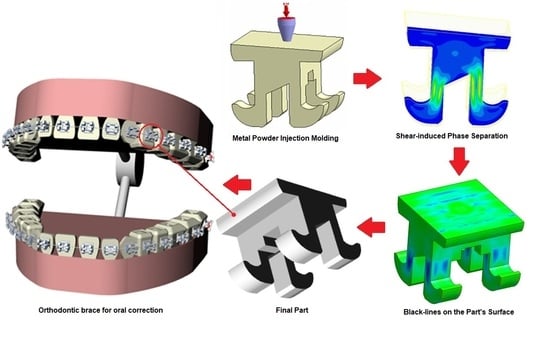Processing Optimization for Metal Injection Molding of Orthodontic Braces Considering Powder Concentration Distribution of Feedstock
Abstract
:1. Introduction
2. Effect and Black Line Formation
2.1. Shear-Induced Phase Separation Effect
2.2. Formation of Black Lines
2.3. Metal Powder Concentration Distribution
3. MIM Simulations
3.1. Mold Flow Analysis
3.2. Taguchi Experiments
3.3. Factor Level Settings
4. Results and Discussion
4.1. Relative Contributions of Control Factors
4.2. Optimal Factor Level Settings
4.3. Verification of Optimal Processing Parameters
4.4. Relationship between Metal Powder Concentration Distribution and Black Line Formation
5. Conclusions
- The MIM control factors can be ranked in terms of a decreasing effect on the powder particle concentration distribution as follows: filling time > melt temperature > packing pressure > mold temperature > gate size.
- The uniformity of the powder particle concentration distribution can be improved by using a shorter filling time, a higher melt temperature, a lower packing pressure, a lower mold temperature, and a smaller gate size.
- For the orthodontic brace considered in the present study (see Figure 1), the optimal processing conditions are as follows: (A) filling time 0.15 s, (B) packing pressure 14 MPa, (C) melt temperature 230 °C, (D) mold temperature 30 °C, and (E) gate size 0.25 mm.
- The optimal processing conditions reduce the standard deviation of the particle powder concentration distribution by 48.92% compared to that in the original process design.
- The optimal processing conditions yield an effective reduction in the peak shear strain rate induced during the molding process. Consequently, the phase separation effect of the metal powder particles within the composite feedstock material is also reduced, and hence the formation of black lines on the surface of the molded brace is suppressed.
Author Contributions
Funding
Acknowledgments
Conflicts of Interest
References
- German, R.M. Injection molding of metals and ceramics. Metal Powder Ind. Fed. 1997, 3, 413. [Google Scholar]
- Williams, B. Parmatech Shapes Metals like Plastics. Metal Powder Rep. 1989, 44, 675–680. [Google Scholar]
- Berginc, B.; Kampus, Z.; Sustarsic, B. The Use of Taguchi Approach to Determine the Influence of Injection Molding Parameters on the Properties of Green Parts. J. Achiev. Mater. Manuf. Eng. 2006, 15, 63–70. [Google Scholar]
- Johnson, J.; Heaney, D.; Myers, N. Metal Injection Molding (MIM) of Heavy Alloys, Refractory Metals, and Hardmetals. In Handbook of Metal Injection Molding; Elsevier BV: Amsterdam, The Nederland, 2012; pp. 526–567. [Google Scholar]
- German, R.M. Metal Powder Injection Molding (MIM): Key Trends and Markets. In Handbook of Metal Injection Molding; Elsevier BV: Amsterdam, The Nederland, 2012; pp. 1–25. [Google Scholar]
- Available online: https://zh.wikipedia.org/wiki/%E9%87%91%E5%B1%AC%E5%B0%84%E5%87%BA%E6%88%90%E5%9E%8B (accessed on 7 November 2020).
- Thornagel, M. MIM-Simulation: A Virtual Study on Phase Separation. In Proceedings of the EURO PM, Copenhagen, Denmark, 12–14 October 2009. [Google Scholar]
- Thornagel, M. Injection moulding simulation: New developments offer rewards for the PIM industry. Powder Inject. Mould. Int. 2012, 6, 65–68. [Google Scholar]
- German, R.M. Homogeneity Effects on Feedstock Viscosity in Powder Injection Moulding. J. Am. Ceram. Soc. 1994, 77, 283–285. [Google Scholar] [CrossRef]
- Barriere, T.; Liu, B.; Gelin, J.-C. Determination of the optimal process parameters in metal injection molding from experiments and numerical modeling. J. Mater. Process. Technol. 2003, 636–644. [Google Scholar] [CrossRef]
- Amin, S.Y.M.; Muhamad, N.; Jamaludin, K.R. Optimization of Injection Molding Parameters for WC-Co Feedstocks. J. Teknol. 2013, 63. [Google Scholar] [CrossRef] [Green Version]
- Ross, P.J. Taguchi Techniques for Quality Engineering; Tata McGraw Hill: New York, NY, USA, 1989. [Google Scholar]
- Roy, R.K. Design of Experiments Using the Taguchi Approach; John Wiley & Sons: Hoboken, NJ, USA, 2001. [Google Scholar]
- Available online: http://www.caemolding.org/acmt/pimacn2015/D1-0616-DG/D1K1-05.pdf (accessed on 7 November 2020).
- Available online: https://zh.wikipedia.org/wiki/%E6%A8%99%E6%BA%96%E5%B7%AE (accessed on 7 November 2020).
- Available online: https://www.moldex3d.com/ch/blog/tips-and-tricks/blm-parameter-setting-guide-to-enhance-modeling/ (accessed on 7 November 2020).
- Available online: http://support.moldex3d.com/r15/zh-TW/modelpreparation_referencepre_threemeshtypesofsolidmeshingmethod.html (accessed on 7 November 2020).
- Lee, H.H. Taguchi Methods Principles and Practices of Quality Desig; GauLih Book Co. Ltd.: New Taipei, Taiwan, 2011. [Google Scholar]

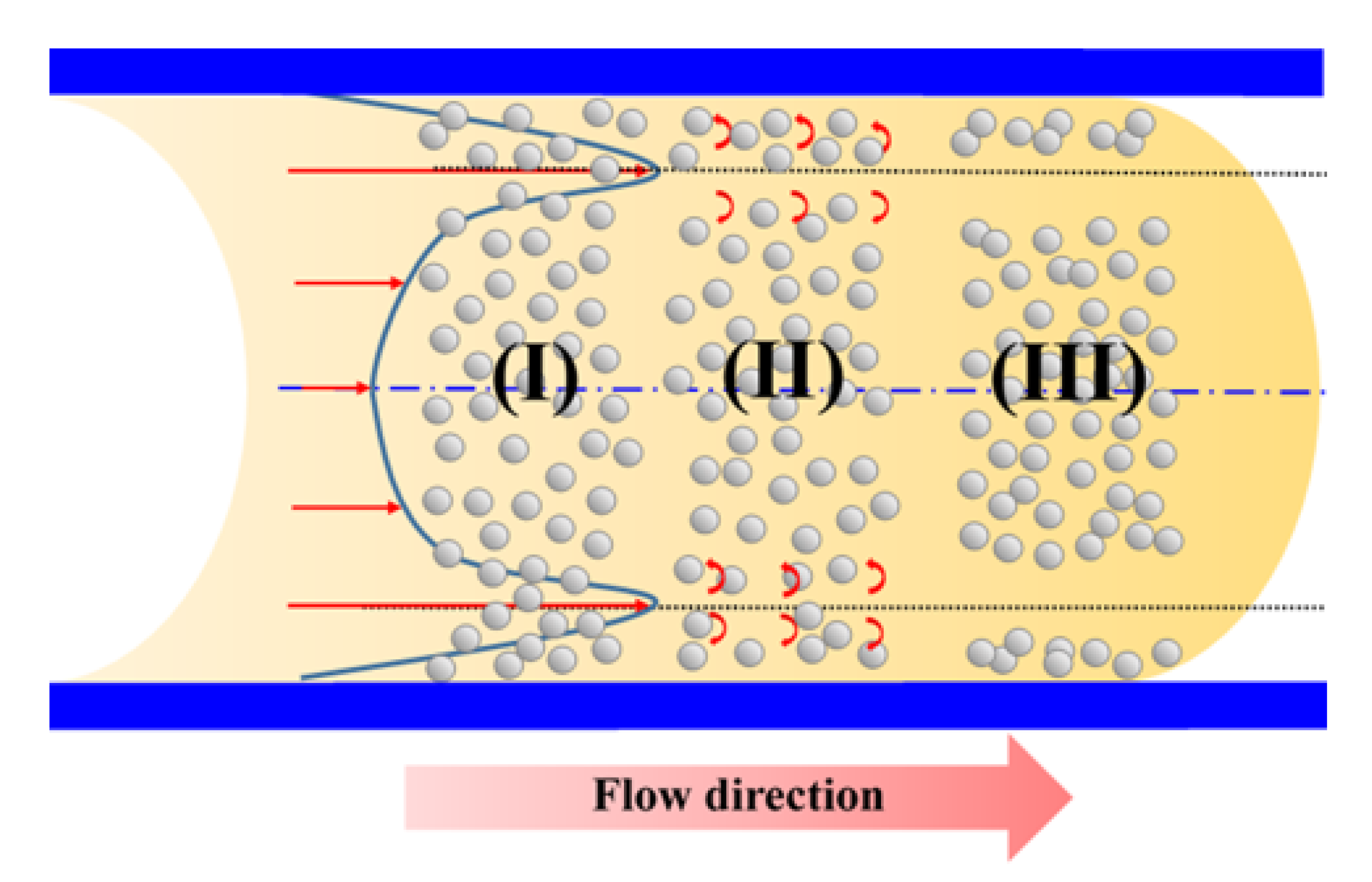
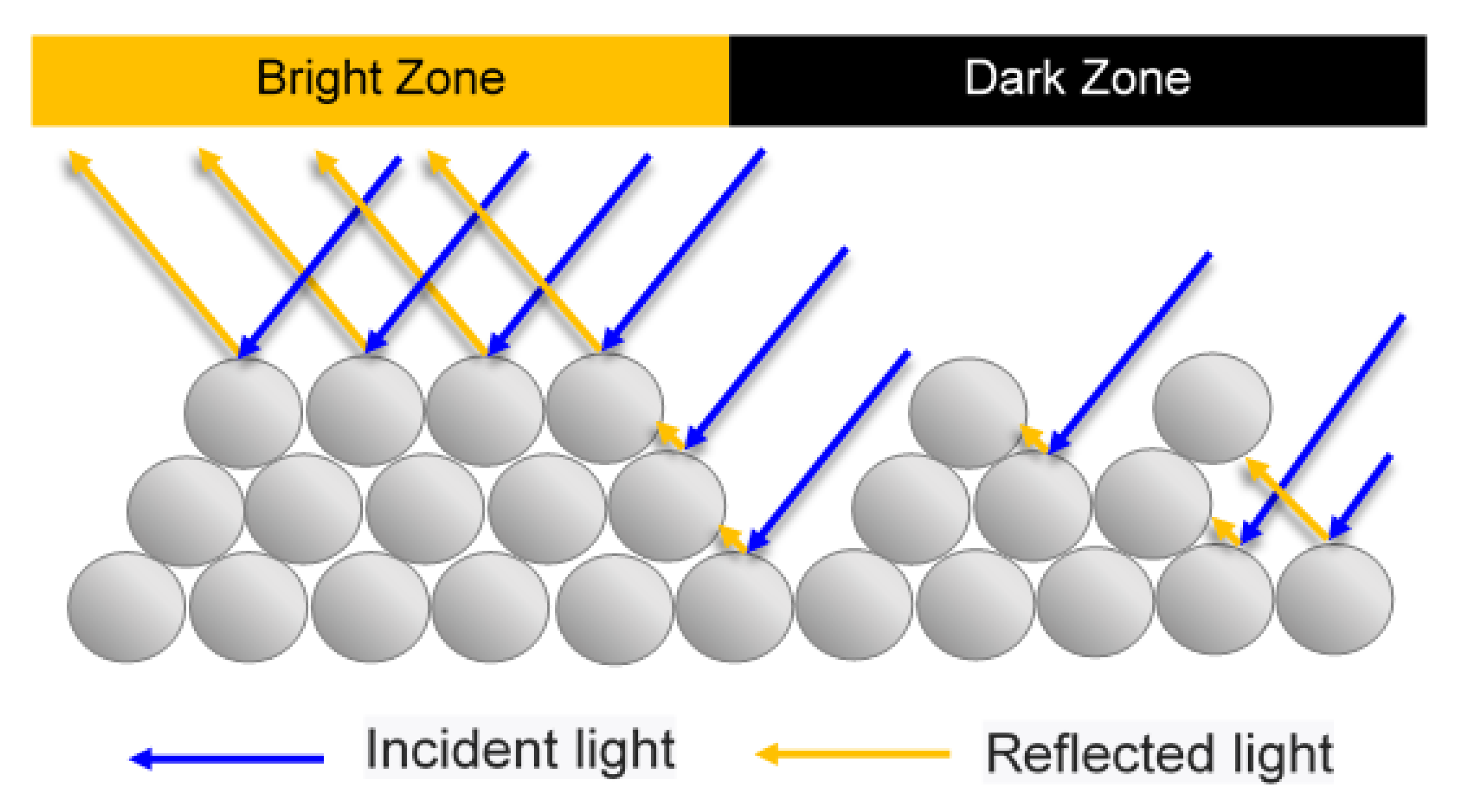
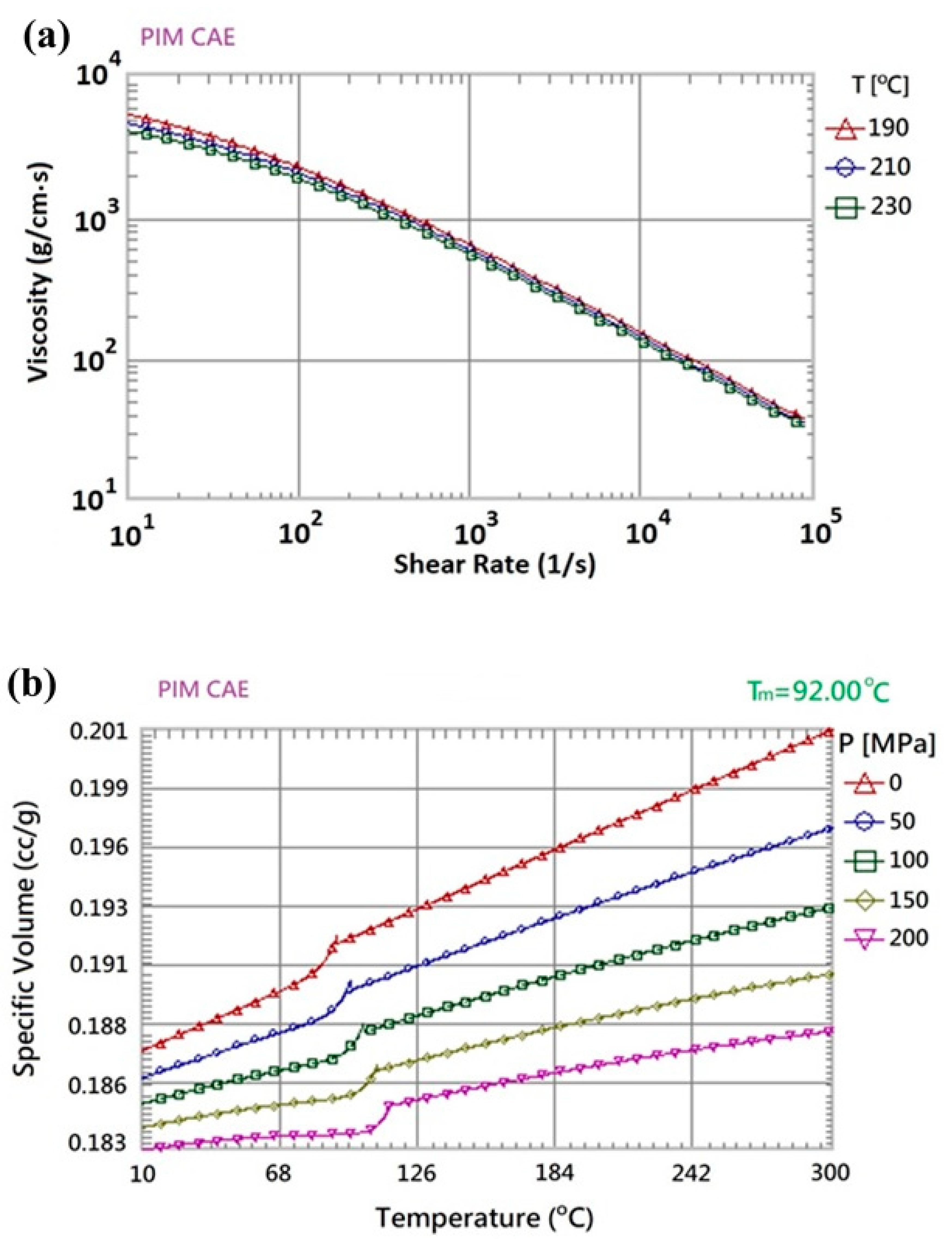

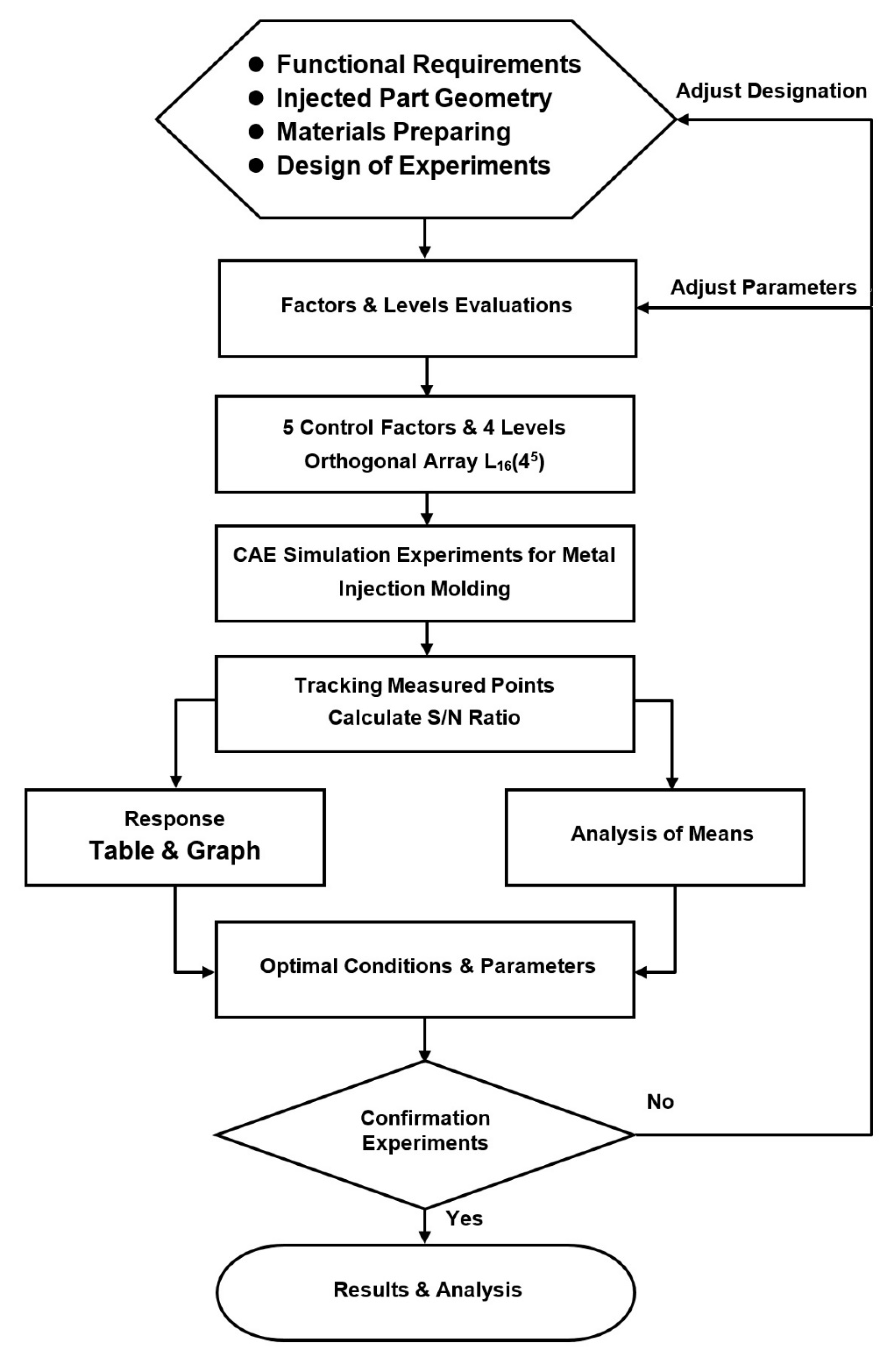
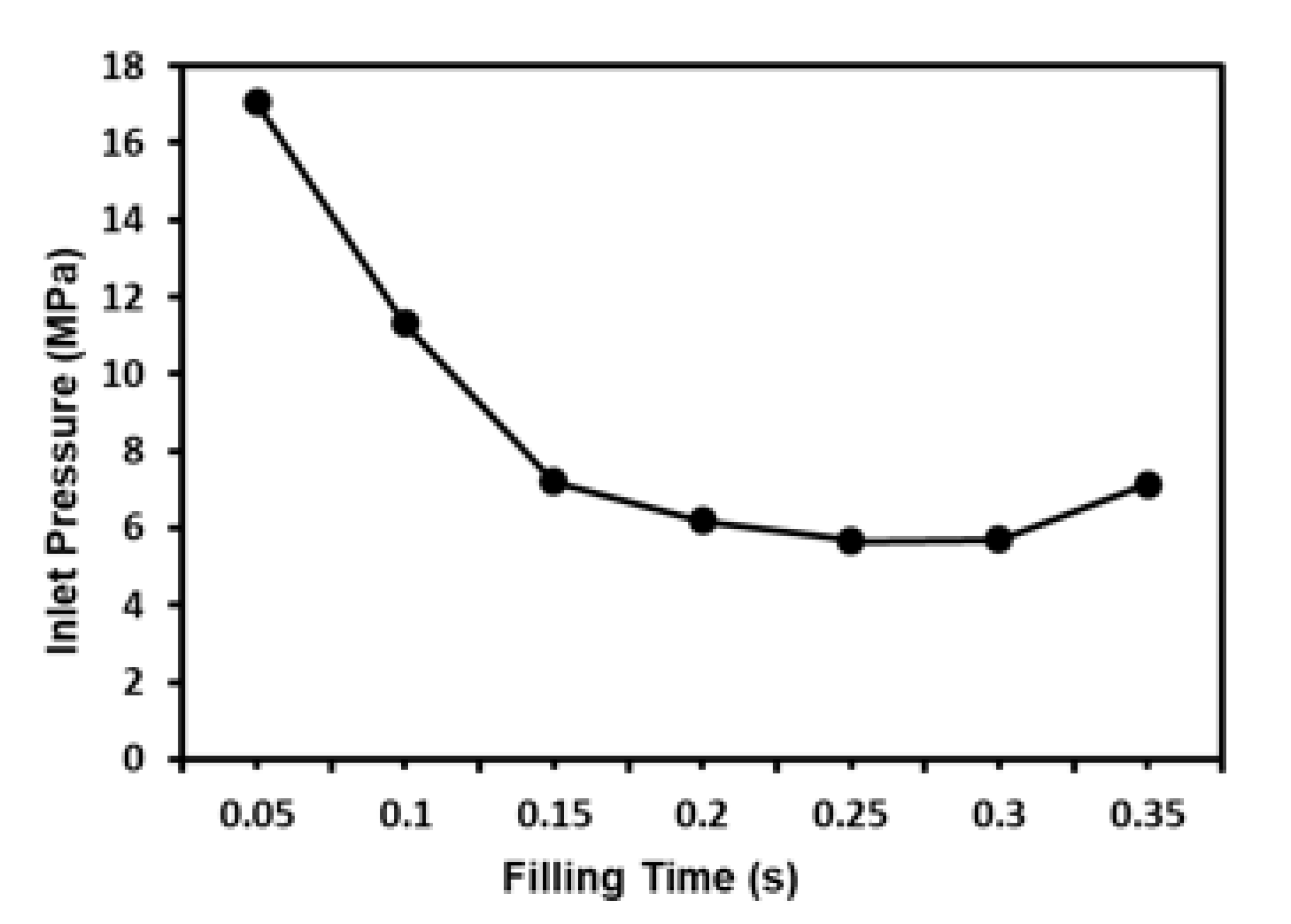
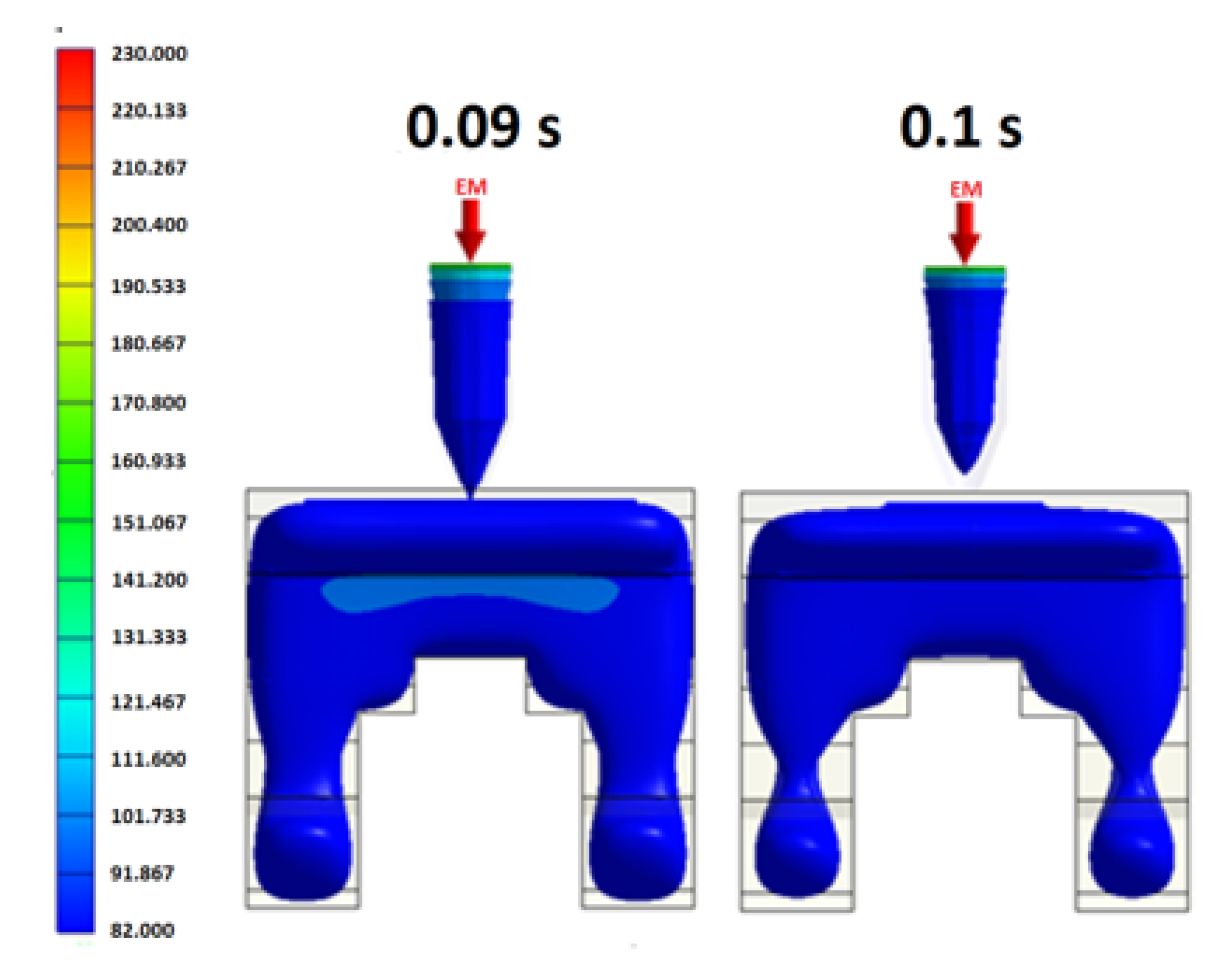

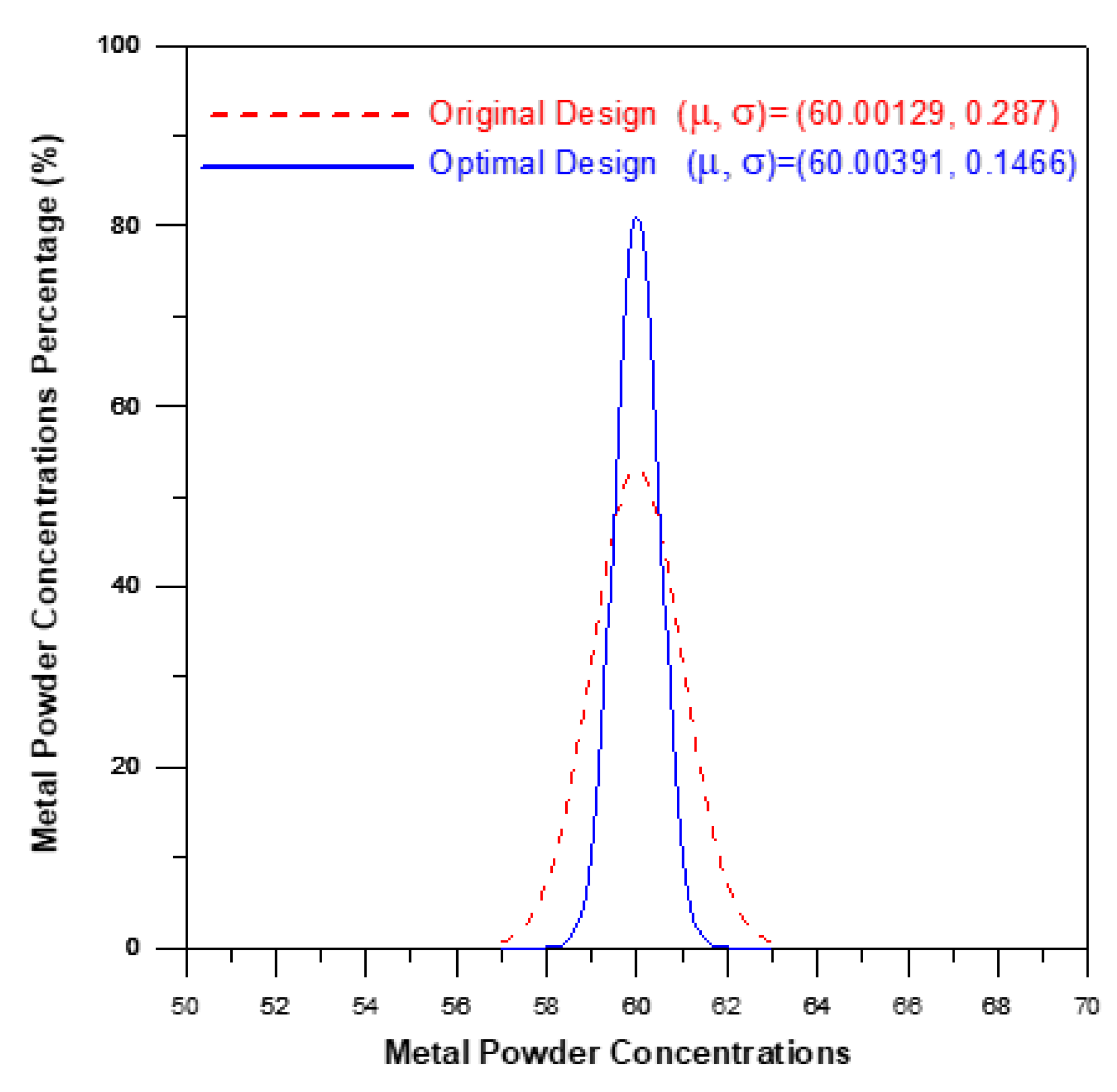


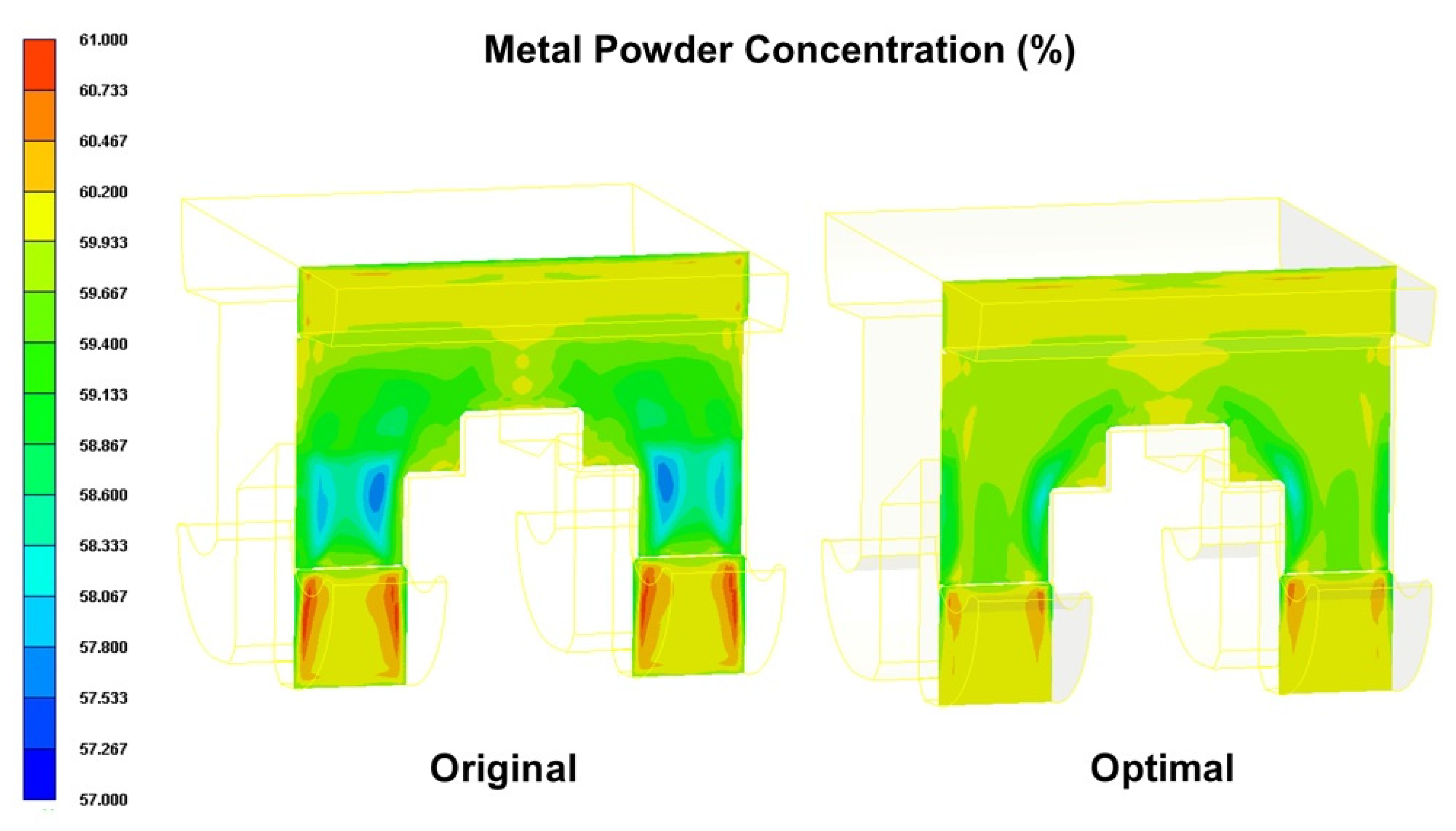
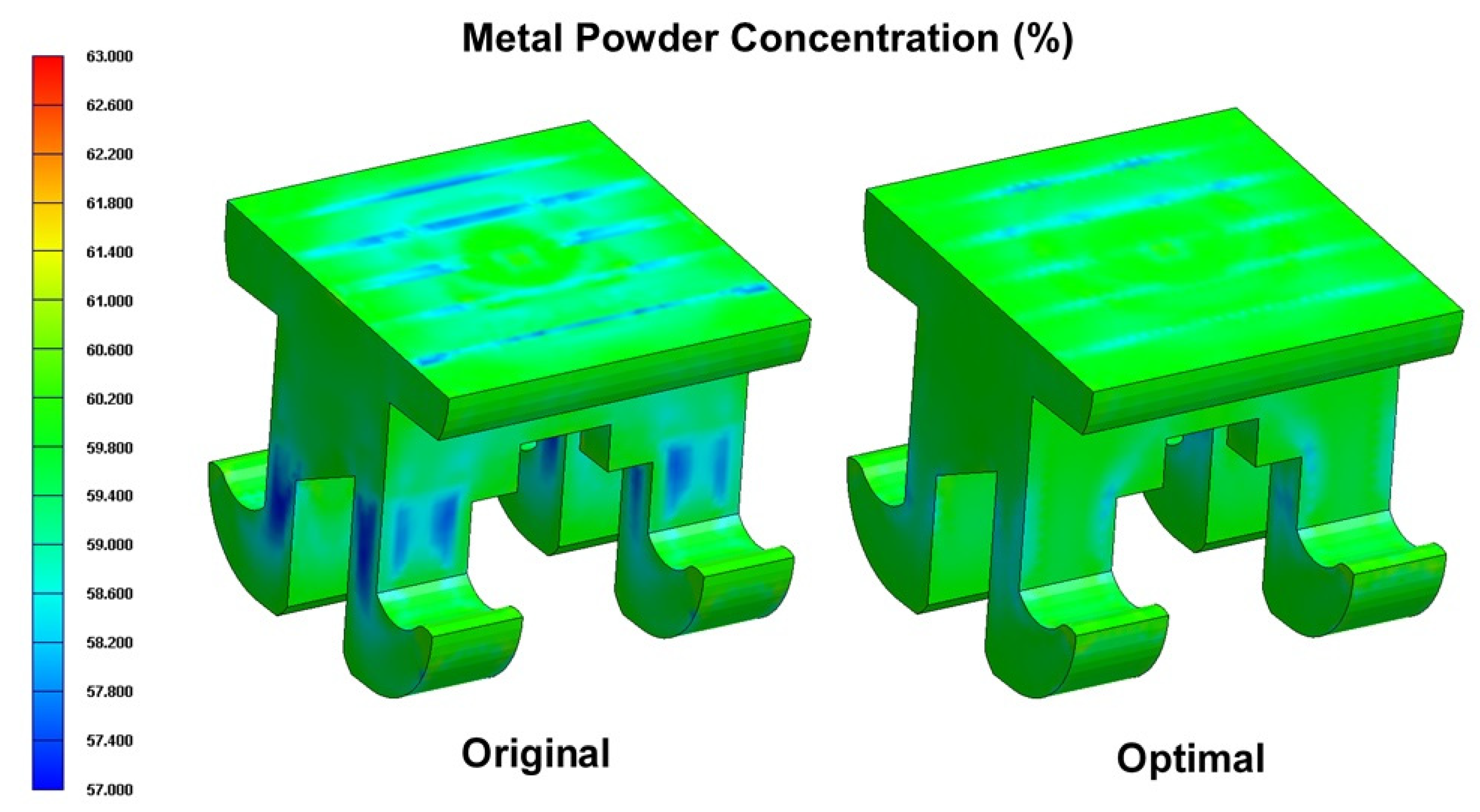
| Metal Powder | Binding Agent | |
|---|---|---|
| Specifics | Stainless steel | Polypropylene (PP) |
| Volume fraction | 60% | 40% |
| Density | 7.9 g/cc | 0.91 g/cc |
| Particle dimension | 10 microns | - |
| L16 (45) | A | B | C | D | E |
|---|---|---|---|---|---|
| Filling Time (s) | Packing Pressure (MPa) | Melt Temperature | Mold Temperature | Gate Size (mm) | |
| Level 1 | 0.15 | 14 | 200 | 30 | 0.2 |
| Level 2 | 0.2 | 16 | 210 | 40 | 0.25 |
| Level 3 | 0.25 | 18 | 220 | 50 | 0.3 |
| Level 4 | 0.3 | 20 | 230 | 60 | 0.35 |
| Exp. | A Filling Time (s) | B Packing Pressure (MPa) | C Melt Temperature | D Mold Temperature | E Gate Size (mm) | (60%) | S/N (dB) |
|---|---|---|---|---|---|---|---|
| 1 | 0.15 | 14 | 200 | 30 | 0.2 | 1.00103 | −0.2179 |
| 2 | 0.15 | 16 | 210 | 40 | 0.25 | 1.00065 | −0.1902 |
| 3 | 0.15 | 18 | 220 | 50 | 0.3 | 1.0003 | −0.1509 |
| 4 | 0.15 | 20 | 230 | 60 | 0.35 | 1.00015 | −0.1194 |
| 5 | 0.2 | 14 | 210 | 50 | 0.35 | 1.00015 | −0.2329 |
| 6 | 0.2 | 16 | 200 | 60 | 0.3 | 1.00023 | −0.3732 |
| 7 | 0.2 | 18 | 230 | 30 | 0.25 | 1.0006 | −0.1547 |
| 8 | 0.2 | 20 | 220 | 40 | 0.2 | 1.00103 | −0.1799 |
| 9 | 0.25 | 14 | 220 | 60 | 0.25 | 1.00056 | −0.2588 |
| 10 | 0.25 | 16 | 230 | 50 | 0.2 | 1.00103 | −0.2548 |
| 11 | 0.25 | 18 | 200 | 40 | 0.35 | 1.00009 | −0.4556 |
| 12 | 0.25 | 20 | 210 | 30 | 0.3 | 1.00022 | −0.3455 |
| 13 | 0.3 | 14 | 230 | 40 | 0.3 | 1.0002 | −0.2709 |
| 14 | 0.3 | 16 | 220 | 30 | 0.35 | 1.0001 | −0.3404 |
| 15 | 0.3 | 18 | 210 | 60 | 0.2 | 1.00106 | −0.4546 |
| 16 | 0.3 | 20 | 200 | 50 | 0.25 | 1.00051 | −0.4597 |
| Optimization | 0.15 | 14 | 230 | 30 | 0.25 | 1.00065 | −0.1191 |
| S/N(dB) | A | B | C | D | E |
|---|---|---|---|---|---|
| Level 1 | −0.16961 | −0.24516 | −0.37662 | −0.26464 | −0.27684 |
| Level 2 | −0.23521 | −0.28966 | −0.30581 | −0.27416 | −0.26584 |
| Level 3 | −0.32868 | −0.30395 | −0.23249 | −0.27458 | −0.28511 |
| Level 4 | −0.38139 | −0.27612 | −0.19998 | −0.30151 | −0.28709 |
| Range | 0.211784 | 0.058797 | 0.176641 | 0.036867 | 0.021249 |
| Contribution | 41.90% | 11.64% | 34.96% | 7.30% | 4.20% |
| Rank | 1 | 3 | 2 | 4 | 5 |
Publisher’s Note: MDPI stays neutral with regard to jurisdictional claims in published maps and institutional affiliations. |
© 2020 by the authors. Licensee MDPI, Basel, Switzerland. This article is an open access article distributed under the terms and conditions of the Creative Commons Attribution (CC BY) license (http://creativecommons.org/licenses/by/4.0/).
Share and Cite
Lin, C.-M.; Wu, J.-J.; Tan, C.-M. Processing Optimization for Metal Injection Molding of Orthodontic Braces Considering Powder Concentration Distribution of Feedstock. Polymers 2020, 12, 2635. https://doi.org/10.3390/polym12112635
Lin C-M, Wu J-J, Tan C-M. Processing Optimization for Metal Injection Molding of Orthodontic Braces Considering Powder Concentration Distribution of Feedstock. Polymers. 2020; 12(11):2635. https://doi.org/10.3390/polym12112635
Chicago/Turabian StyleLin, Chao-Ming, Jhih-Jyun Wu, and Chung-Ming Tan. 2020. "Processing Optimization for Metal Injection Molding of Orthodontic Braces Considering Powder Concentration Distribution of Feedstock" Polymers 12, no. 11: 2635. https://doi.org/10.3390/polym12112635




